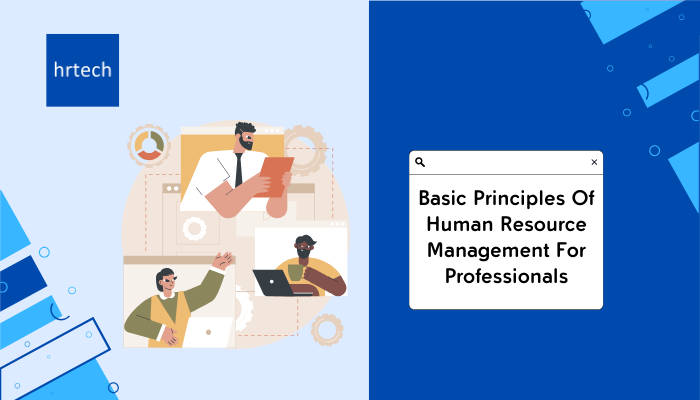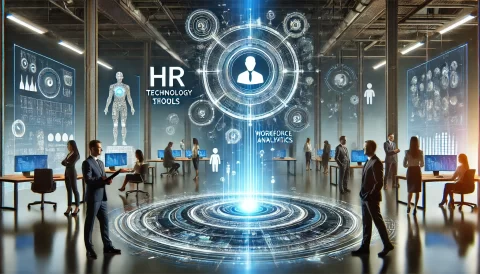In this guide, you’ll learn all the basic principles of HR management with helpful diagrams and detailed insights.
So, are you ready to brush up your HR fundamentals? Let’s dive in!
What Is Human Resource Management?
Human Resource Management (HRM) is all about taking care of the people who work for a company. It’s the job of HR to make sure the company has the right number of workers with the right skills to do their jobs well.
Definition And Purpose Of HRM:
- HRM is the process of hiring, training, and managing employees.
- The goal is to help the company succeed by having a strong team of employees.
Role Of HR Managers In HRM:
HR managers are in charge of:
- Finding and hiring new employees.
- Providing training to help employees improve their skills.
- Making sure employees are happy and productive at work.
In the past, HR focused mainly on basic tasks like payroll and benefits. Today, HR plays a bigger role in helping companies plan for the future.
In the coming years, HR will need to adapt to changes in technology and the way people work.
Check out this guide on trending HR topics to learn more about the latest trends in the HR world.
Now that we know what HRM is all about, let’s understand some theoretical frameworks that influence HR principles.
Frameworks That Influence HR Principles
HRM as we know it today is the product of theoretical findings from research by numerous researchers and practitioners. These frameworks or theoretical models are at the core of modern HRM practices.
Let’s take a look at some of the theoretical frameworks:
1. Maslow’s Hierarchy of Needs
Maslow’s Hierarchy of Needs is a psychological framework that explains what motivates people. It is often shown as a pyramid with five levels, starting from basic survival needs to personal growth.
- Physiological Needs: These are basic necessities like food, water, and shelter. Employees need fair wages and a safe working environment to meet these needs.
- Safety Needs: People seek job security, financial stability, and a safe workplace. HR policies like contracts, benefits, and workplace safety measures address this.
- Social Needs: Employees want to feel a sense of belonging. Teamwork, a positive workplace culture, and employee engagement initiatives help fulfill this need.
- Esteem Needs: People want recognition and respect. HR can support this by offering promotions, rewards, and professional development opportunities.
- Self-Actualization: This is about personal growth and fulfillment. Providing challenging work, career advancement, and skill development opportunities help employees reach their full potential.
2. Herzberg’s Two-Factor Theory
Herzberg’s theory divides workplace factors into two categories:
1. Hygiene Factors (Prevents Dissatisfaction)
Here are some of the hygiene factors in an organization:
- Salary and benefits are fair and competitive.
- Job security and clear company policies are in place.
- A safe and comfortable work environment is provided.
- Healthy relationships with colleagues and managers are encouraged.
2. Motivational Factors (Increase Satisfaction)
Here are some of the motivational factors in an organization:
- Employees receive recognition and appreciation for their work.
- Career growth opportunities and skill development programs are available.
- Work is meaningful and allows employees to take ownership.
- Employees feel a sense of achievement in their roles.
3. SHRM’s Competency Model
The Society for Human Resource Management (SHRM) Competency Model outlines key skills HR professionals need to succeed.
It includes:
- Business Acumen: Understanding business strategy and financial impact.
- HR Expertise: Knowledge of HR principles, policies, and laws.
- Leadership & Navigation: Guiding teams and driving organizational success.
- Ethical Practice: Maintaining integrity and fairness in HR decisions.
- Relationship Management: Building strong workplace relationships.
- Consultation: Advising leaders and employees on HR matters.
- Critical Evaluation: Using data to make informed HR decisions.
- Global & Cultural Effectiveness: Managing diversity and inclusion.
- Communication: Effectively conveying HR policies and information.
Also Read: “Top 15 Tips For Managing Human Resources Effectively”.
While over the years these theoretical models have evolved, the core principles remain the same. Similarly, HR roles may have evolved but the core responsibilities of HR remain the same. Let’s take a closer look at some core responsibilities of HR management.
Core Responsibilities Of HR Management
HR managers have many important jobs to do to keep their companies running well. Let’s look at the main things they are in charge of.
1. Recruitment And Selection
- HR looks at what jobs the company needs and writes clear descriptions.
- They post job ads, look at resumes, and interview candidates.
- When a new person is hired, HR helps them get started and feel welcome.
For example, if a company needs a new salesperson, HR will figure out what skills the person needs, find the best candidates, and help the new hire learn about the company.
2. Learning And Development
- HR finds out what training employees need to do their jobs better.
- They create training programs that match the company’s goals.
- HR tracks how well the training works and makes changes if needed.
If a company wants to sell more products online, HR might create a training program to teach employees about e-commerce.
3. Performance Management
- HR sets goals for employees and checks how well they are doing.
- They give feedback and advice to help employees do their best work.
- If someone is having trouble, HR works with them to find solutions.
For instance, HR might meet with an employee every 6 months to talk about their work and set new goals for the next 6 months.
4. Compensation And Benefits
- HR makes sure employees are paid fairly based on their skills and experience.
- They research other companies to see what benefits and pay are common.
- HR explains the pay and benefits to employees so they understand their package.
For example, HR might look at salary surveys to make sure the company’s pay is similar to others in the same industry.
5. Employee Relations
- HR listens to employees’ concerns and helps solve problems.
- They plan events and programs to make employees feel valued and connected.
- HR works to create a positive company culture where people want to work.
If there are any issues or disputes among the team members, then HR can talk with them and find out a solution, resolving the issue.
6. Legal Compliance
- HR makes sure the company follows all the rules about how to treat workers.
- They stay up-to-date on changes to laws about things like pay, time off, and safety.
- HR keeps records to show the company is doing what it’s supposed to.
For example, HR can post certain regulations in the workplace to ensure everyone sees and follows them accordingly.
7. HR Data And Analytics
- HR collects data about things like employee turnover, hiring, and training.
- They use this data to spot trends and see where the company can improve.
- HR shares their findings with leaders to help make smart choices for the future.
For instance, if the data shows that many employees are leaving after 1 year, HR might implement strategies to help keep people longer.
So, these core responsibilities show how HR helps companies succeed by taking care of their people. Next, we’ll explore the key principles that guide how HR professionals approach these important tasks.
Principles Of Human Resource Management
HR professionals follow important principles to make sure they are treating employees fairly and helping the company succeed. Let’s dive into these key ideas that guide HR’s work.
1. Dignity Of Labor
Every job in a company matters, from the entry-level workers to the top bosses. HR’s job is to make sure everyone feels respected and valued, no matter what their role is.
- When employees feel their work is important, they are more motivated to do their best.
- Treating all staff with respect creates a positive company culture.
- Valuing all roles helps the company work together as a team.
For example, a company could have a special award that recognizes employees at all levels for their hard work and dedication.
2. Individual Development
HR should give all employees the chance to learn and grow in their careers. This means offering training, mentoring, and other resources to help people build their skills.
How HR can support individual development:
- Create a clear career path for each role, so employees know how they can advance.
- Offer regular training sessions on topics that match the company’s needs and goals.
- Let newer employees collaborate with experienced mentors who can guide them.
For instance, HR might create a leadership training program that any employee can apply for, regardless of their current job title.
Here’s a detailed guide on types of corporate training programs. Check it out to learn more about different training programs for employee development.
3. Participation
HR should involve employees in making decisions that affect their work. This helps people feel like their opinions matter and encourages teamwork.
Benefits of employee participation:
- Employees who feel heard are more engaged and loyal to the company.
- Collaborative decision-making leads to better ideas and solutions.
- Inclusive practices create a sense of belonging and shared purpose.
For instance, an HR can host regular meetings where employees can ask questions and give feedback directly to company leaders.
Now, let’s explore a few more key principles that guide HR professionals in their important work.
4. Fair Remuneration And Incentives
HR must make sure employees are paid fairly for their work. This means looking at what other companies pay for similar jobs and offering competitive salaries and benefits.
Why is fair pay important?
- Employees who feel they are paid fairly are more likely to stay with the company.
- Fair pay helps attract top talent when hiring for new roles.
- Proper compensation shows employees that their work is valued.
How HR can ensure fair remuneration:
- Research market rates for each job role and level.
- Create clear pay scales based on skills, experience, and performance.
- Offer incentives like bonuses or profit-sharing to reward good work.
5. Scientific Selection
HR should use proven methods to find and hire the best candidates for each job. This means looking beyond just resumes and using tools like skills assessments and structured interviews.
Benefits of scientific selection:
- Helps reduce bias in hiring decisions.
- Identifies candidates with the right skills and experience for the job.
- Leads to better job performance and lower turnover.
Tools for scientific selection:
- Pre-employment tests to measure skills and knowledge.
- Behavioral interviews with standardized questions.
- Reference checks and background screenings.
For instance, for a technical role, HR might give candidates a coding test to see how well they can solve problems related to the job in real life. This gives a more objective measure of their abilities than just looking at their resume.
6. Team Spirit
HR should also encourage a culture of collaboration and teamwork. This means creating opportunities for employees to work together and recognizing team achievements.
Why team spirit is essential:
- Encourages employees to share ideas and support each other.
- Leads to better problem-solving and innovation.
- Boosts morale and job satisfaction.
How HR can build team spirit:
- Plan team-building activities and events.
- Recognize and reward team successes, not just individual achievements.
- Encourage cross-functional collaboration on projects.
7. Free Flow Of Communication
HR should make sure there are clear and open lines of communication between employees and managers. This means encouraging regular feedback, both positive and constructive.
Benefits of open communication:
- Helps identify and solve problems early on.
- Gives employees a voice in decision-making.
- Builds trust and transparency in the workplace.
Ways to promote open communication:
- Hold regular one-on-one meetings between employees and their managers.
- Conduct employee surveys to gather feedback and ideas.
- Provide training on effective communication skills.
8. HR Principles in a Global Context
As businesses expand internationally, HR must adapt strategies to meet the needs of a diverse workforce. This includes adjusting to cultural differences, managing global talent, and ensuring inclusive work environments.
1. Adapting HR Strategies Across Different Cultures
HR policies and management styles should reflect cultural norms to ensure employee engagement and productivity. What works in one country may not be effective in another.
- Leadership styles vary—some cultures prefer hierarchy, while others value collaboration.
- Work-life balance expectations differ; flexible work policies may be crucial in some regions.
- Communication norms affect feedback, conflict resolution, and workplace interactions.
2. Global Talent Acquisition
Hiring in different regions requires understanding local job markets, labor laws, and recruitment trends. A one-size-fits-all hiring approach may not be effective.
- Use region-specific job platforms and social media for hiring.
- Adapt job descriptions and benefits to local expectations.
- Ensure compliance with labor laws regarding contracts, benefits, and work permits.
Also Read: “Hire Across Borders & Win the Talent War”.
3. DEI (Diversity, Equity, and Inclusion) Initiatives
Creating an inclusive workplace is essential for attracting and retaining a diverse workforce. DEI initiatives should go beyond policies and be actively implemented.
- Establish unbiased recruitment processes and diverse hiring panels.
- Provide cultural competency and sensitivity training.
- Ensure equal growth opportunities, pay equity, and representation at all levels.
Companies today implement DEI initiatives using digital platforms and hrtech marketplace brings you the best DEI tools in the market. Schedule a consultation today and get best personalized recommendations on top DEI tools.
Now that we understand the guiding principles of HR management, let’s take a closer look at the underlying functions that HR professionals perform to put these principles into practice.
Underlying Functions In HR Management
HR professionals have several key functions they perform to keep their companies running smoothly and support employees. Let’s dive into these core areas of HR work.
Strategic Planning
One of the most important things HR does is make sure their plans and actions match what the company wants to achieve. This is called strategic planning.
How HR does strategic planning:
- Look at the company’s overall business plan and goals.
- Figure out what skills and people are needed to reach those goals.
- Create HR plans for hiring, training, and managing employees that support the company’s direction.
For instance, if a company wants to expand into a new country, HR would plan how to hire people with the right language and cultural skills to make that happen.
Employee Orientation And Development
When a new person joins the company, HR helps them learn about the job and the workplace. This is called orientation. HR also gives employees chances to learn and grow in their careers, which is called development.
Benefits of orientation and development:
- Helps new hires feel welcome and understand their role.
- Teaches employees new skills that can help them do their jobs better.
- Shows employees that the company cares about their growth and success.
Ways HR provides orientation and development:
- Create a clear onboarding plan for new hires.
- Offer regular training sessions on job-related topics.
- Give employees opportunities to attend conferences or workshops.
- Provide mentoring or coaching programs.
For instance, during a new hire’s first week, HR might set up meetings with key people, give them a tour of the office, and have them complete training on company policies.
Performance Management
HR helps employees understand how well they are doing their jobs and where they can improve. This is called performance management.
Why performance management is important:
- Gives employees clear expectations and feedback on their work.
- Helps identify areas where employees need more training or support.
- Allows the company to reward top performers and address underperformance.
Tools for effective performance management:
- Regular check-ins between employees and their managers.
- Clear goals and metrics for each job role.
- Performance reviews that provide specific feedback and next steps.
- Reward programs for employees who exceed expectations.
Employee Relations And Positive Work Environment
HR works to create a workplace where employees feel valued, respected, and engaged. This is called employee relations.
Benefits of good employee relations:
- Higher job satisfaction and morale.
- Lower turnover rates and absenteeism.
- Better collaboration and teamwork.
How HR supports employee relations:
- Listen to employee concerns and feedback.
- Provide resources for conflict resolution and problem-solving.
- Organize events and activities that build community and morale.
- Recognize and celebrate employee achievements.
Safety And Compliance
HR makes sure the workplace is safe and follows all relevant laws and regulations. This includes things like health and safety rules, anti-discrimination policies, and labor laws.
Why safety and compliance matter:
- Protects employees from accidents and injuries.
- Prevents legal issues and fines for the company.
- Creates a fair and respectful workplace for all.
How HR ensures safety and compliance:
- Develop and follow safety policies and procedures.
- Train employees on compliance and regulation-related topics.
- Keep records and documentation to ensure compliance with regulations.
Evolution And Future Of HRM
HR has come a long way over the years. Let’s take a look at how HR is changing with time and what the future might look like:
From Administrative Functions To Strategic Partnership
In the past, HR was mostly about paperwork and rules. They handled things like payroll, benefits, and personnel files. But now, HR is becoming a real partner in helping the company succeed.
HR’s expanding role:
- Working with leaders to make plans for the future
- Finding ways to make employees happier and do their best work
- Using data to spot trends and solve problems
As technology changes, so does the way we work. HR has to keep up with these changes and find ways to use technology to make things better for employees.
How HR Is Evolving:
- Creating better and more remote work policies.
- Using online tools for hiring, training, and managing performance.
- Focusing on the employee experience and well-being.
Importance Of Continuous Learning And Adaptation In HR Roles
With all these changes, HR professionals need to keep learning and growing.
Ways HR Can Keep Learning:
- Attend conferences and workshops to learn about new trends.
- Read industry blogs and publications to stay informed.
- Join professional networks and groups to share ideas with others.
Many new HR trends have emerged and it is essential to keep a track of these trends to effectively manage your workforce. These emerging trends are shaping HR principles today. Let’s take a look at some of these emerging trends.
Emerging Trends Shaping HR Principles Today
HR is evolving with advancements in technology and changing workforce expectations. Modern HR practices integrate digital tools and flexible policies while staying aligned with core principles.
1. AI in HR
AI-powered tools help in recruitment, performance analysis, and employee engagement. AI helps you incorporate the principles of evidence based practice into HRM practices. AI also helps you make data-driven decisions.
- AI-driven resume screening ensures unbiased and data-driven hiring.
- Predictive analytics help HR forecast attrition and workforce needs.
- Chatbots improve employee support by handling routine HR queries.
2. Remote & Hybrid Work
Flexible work models have reshaped HR strategies, emphasizing digital collaboration and employee well-being.Remote and hybrid work models are strengthening work life balance and strengthens communication.
- Virtual team-building activities maintain team spirit.
- Clear remote work policies ensure productivity and accountability.
- Digital collaboration tools enhance communication and teamwork.
3. Employee Wellness Programs
HR is prioritizing mental health and well-being as a key factor in employee performance. Employee wellness programs are essential today to increase employee engagement and retention.
- Companies offer mental health support, wellness apps, and stress management programs.
- Flexible schedules and paid wellness days improve work-life balance.
- A focus on holistic well-being boosts employee satisfaction and retention.
Also Read: “HR Employee Engagement Activities for Teams”.
4. HR Tech & Automation
Technology-driven HR solutions improve efficiency and employee experience. Today technology has transformed HRM and has made HR processes smoother and efficient.
- Cloud-based HR platforms simplify payroll, attendance tracking, and benefits management.
- Learning management systems (LMS) enable continuous skill development.
- Automation reduces administrative tasks, allowing HR to focus on strategy.
Find the best automation tools on hrtech marketplace. Schedule a consultation today and get personalized recommendations on the best HRM tools.
With the new HR trends in HRM, various new ways to measure performance of HR functions have also emerged. A clear knowledge of these key performance indicators are important for modern HR professionals. Let’s take a look at some of the most important KPIs in HR management.
How to Measure the Success of HR Principles
Implementing HR principles is essential, but tracking their impact ensures continuous improvement. Key performance indicators (KPIs) help assess how well HR strategies are working and guide future improvements.
Here are some of the core aspects of HRM and KPIs to measure them:
1. Employee Satisfaction & Engagement
A positive work environment leads to higher productivity and retention. Measuring employee satisfaction helps HR understand morale and workplace culture.
- Employee Satisfaction Score (ESS): Measures overall happiness with workplace policies.
- Employee Net Promoter Score (eNPS): Assesses how likely employees are to recommend the company.
- Absenteeism Rate: High absenteeism may indicate dissatisfaction or burnout.
2. Talent Acquisition & Retention
Efficient hiring and low turnover indicate strong HR practices. Tracking these metrics helps optimize recruitment and employee retention strategies.
- Time-to-Hire: Tracks efficiency in filling job vacancies.
- Offer Acceptance Rate: Measures how many candidates accept job offers.
- Turnover Rate: A high turnover signals retention issues and dissatisfaction.
Find the best talent acquisition tools on hrtech marketplace. Schedule a consultation today!
3. Performance & Productivity
A skilled and motivated workforce drives business success. Performance metrics help evaluate training effectiveness and goal achievement.
- Training Return on Investment (ROI): Evaluates how training programs improve performance.
- Goal Achievement Rate: Tracks how well employees meet individual and team objectives.
- Performance Appraisal Scores: Measures employee effectiveness based on HR assessments.
Also Read: “11 Best Performance Management Software In 2025”.
4. DEI & Employee Well-Being
A diverse and inclusive workplace fosters innovation and fairness. Employee wellness initiatives contribute to engagement and job satisfaction.
- Diversity Hiring Ratio: Monitors the diversity of new hires.
- Pay Equity Ratio: Ensures fair compensation across different demographics.
- Wellness Program Participation: Tracks employee engagement in health initiatives.
Also Read: “Top 30 HR KPI Metrics and Indicators Examples for HR Managers in 2024”.
By regularly analyzing these KPIs, HR can refine strategies, enhance employee satisfaction, and improve overall organizational success.
Conclusion
HRM is all about taking care of the people who work for the company and helping the business do well.
From different roles of HR to essential principles of HR management, we covered all topics in this guide.
We also saw how HR has changed over time. It used to be mostly paperwork, but now HR works closely with leaders to make big plans for the company’s future.
As the world changes, HR has to change too. That means using new technology to make work better and create a positive work environment.
Want to learn more about HR and find the best tools and resources to help your team? Check out hrtech today and start transforming your HR team into a strong group that helps your company grow.





